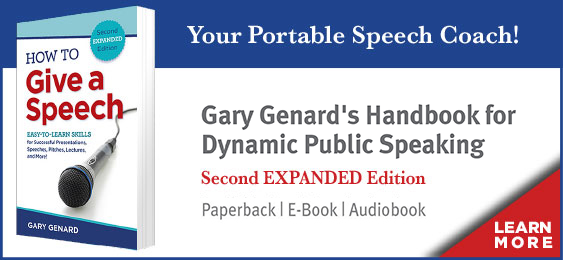Anytime you deliver a speech or presentation, you face a tough task.
You have to capture your attention's attention within the first few seconds. And you have to keep it, stuck to you like glue, until you finish. (To speak dynamically to your important audiences, download my free cheat sheet, "5 Ways to Captivate an Audience.") There are some good reasons why this is so:
- Noise. "Noise" is a constant factor in public speaking. That includes the thousands of messages the average person (your listener) is exposed to every day. It also includes the thoughts and distractions he or she is dealing with, including what happened just before you started speaking.
- Competition. You're speaking at a conference? Join the crowd. A national dental convention once invited me to speak. Just for fun, upon arrival I consulted the master board of all the break-outs. There were 164. Whose talk or workshop will the individual convention-goer remember? That's right: the one from the speaker who captured his or her attention and interest.
- The Law of Diminishing Returns. You've heard of this one: adding more of anything without fundamentally changing the process will ultimately decrease results. Think of the hundreds of uncreative speeches and presentations you've heard, and you'll understand that delivering paint-by-numbers talks leaves everyone comatose rather than enlightened.
The Solution: Novelty and Engagement
These thoughts came to mind when I read Daniel Goleman's recent piece, "How to Capture and Hold Anyone's Attention" (LinkedIn, October 21, 2013). As a speech coach and trainer, reading that title immediately made me think of public speaking.
Attentiveness and emotional engagement are really the name of the game in effective public speaking. Both of these responses reside in the brain's limbic system, which predates the prefrontal cortex in terms of evolutionary development. What does that mean in terms of your being an effective speaker? It means paying attention to two speech tools that happen to align perfectly with what Goleman is saying in his article.
Grabber and Story: Two Essential Speaking Tools
As Goleman reminds us, a person's "orienting response" is triggered by "anything new, novel or surprising." That's exactly what you must give your audience, in terms of a grabber: something you say at the start that hooks listeners' attention and intrigues them enough to attend to everything else that you're about to say. For a list of great grabbers, see my blog "How to Start a Speech! — 12 Foolproof Ways to Open a Speech."
Once you've captured your audience's attention, use the second tool of attentiveness and audience engagement: tell your story. Powerful stories appeal to the brain's emotional centers, and you always want to engage hearts as well as minds. Doing so will remind you that at the center of what you're saying are people, with the emotions, drama, challenges and triumphs that constitute their lives and those of your audience.
You'll need two performance techniques to tell your story effectively: vocal dynamics and body language. For skillful use of your voice, see my "5 Key Tools of Vocal Dynamics." To get your audience to respond to you positively, download my cheat sheet "Dr. Gary Genard's 5 Secrets of Powerful Body Language."
Now, go wow 'em!



